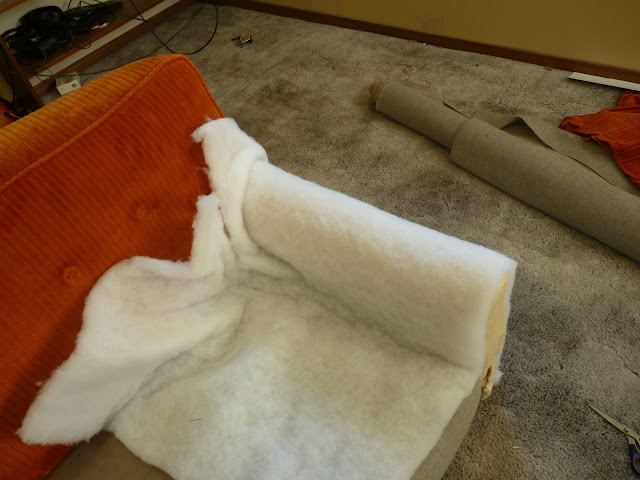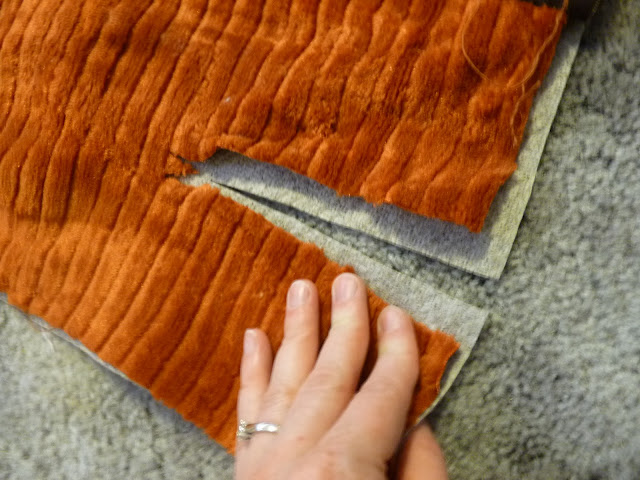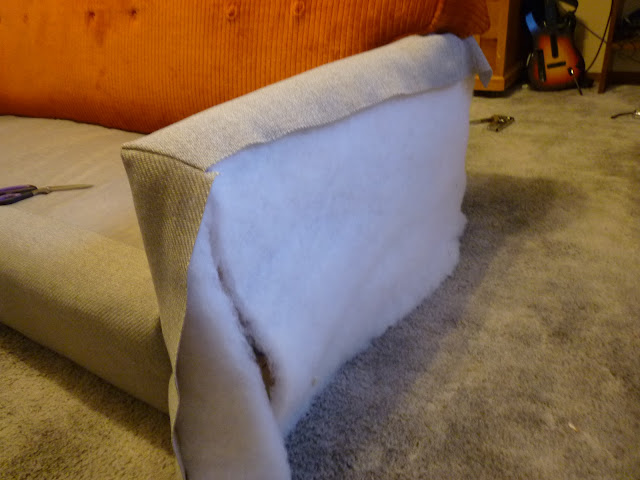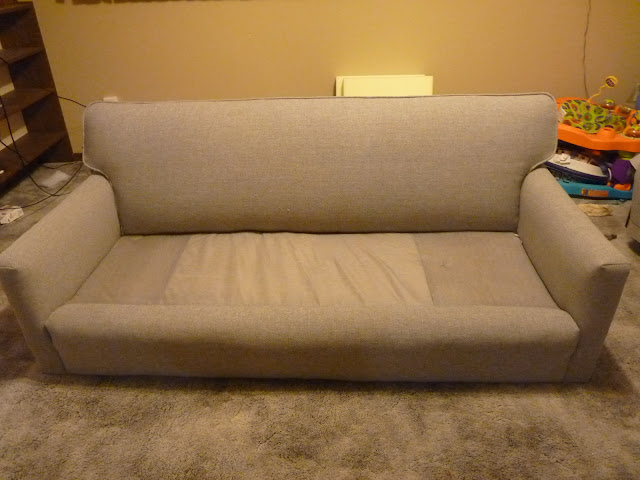After buying a home your bank account may be running a little thin. You may not have the money to buy brand new furniture for your new home. Refurbished furniture has become very popular and saves you tons of money! I found a wonderful step by step demonstration from do-it-yourself design's blog that I found extremely helpful. Enjoy!
How to Re-Upholster a Sofa
http://do-it-yourselfdesign.blogspot.ca/2013/08/how-to-re-upholster-sofa.html
 |
Your sofa can be of any age, shape, size or color! Don't worry about how ugly it is now because that will all change. If you do not have a sofa to refurbish, you can scrounge your nearby thrift store for a great deal. This orange sofa was snatched up for a whopping $35.
TOOLS & MATERIALS:
- Flat butter knife
- Flat-head screw driver
- Pliers
- Hammer
- Staple gun
- Staples
- Approx 6-8 yards of upholstery fabric (more for a sofa bigger than mine)
- Sewing machine with heavy duty needle
- Upholstery piping (if it is currently present on the sofa)
- Upholstery thread
- Screwdriver
- Permanent marker
Optional:
(if needed)
- Cotton batting
- Fabric covered button kit & buttons
- Waxed button cord
- Large upholstery needle (for buttons)
- Cushion zippers (if old ones can not be re-used)
METHOD:
(bare with me, this is a bit of a long process . . .)
1) Remove the bottom covering:
Flip the sofa upside-down so you can access the bottom and take off the legs and accompanying hardware. If you are re-using the legs, put them and the hardware aside. Using in combination your butter knife, flat-head screwdriver and pliers, pull out all of the staples attaching the bottom covering to the bottom of the sofa. Remove the bottom covering and place it aside.
Now is a good time to take a peak at the internal guts of your sofa and make sure everything is in good working order. In an older piece of furniture like mine, it is typical to find a mesh-work of burlap straps like this. These can fray and disintegrate over time, and may need to be patched, replaced or re-secured. It's also good to check for loose, bent, or rusted springs that may need attention. You'll also want to check on the condition of the wood frame and see how it's holding up. In my case, some of the original burlap straps had disintegrated, but I wasn't the first person to re-upholster this piece, and the last guy did a good job of repairing the damage which was still holding strong, so it didn't need much attention from me.
2) Release the fabric from around the bottom of the sofa:
Pick out all the staples from the bottom of the sofa frame, releasing the existing upholstery fabric from around the bottom of the sofa:
In the case of my particular sofa, I also had this pleated flange around the bottom of the sofa which had to be removed. This was purely a decorative piece that I didn't plan to add to my final product, so I just discarded it once I had it free from the rest of the sofa. If I did want a pleated flange on the final product, I would keep this piece and place it aside until all the rest of the sofa was finished.

 |
| Staples hidden on the under-side of the flange. |
3) Remove the back:
Flip the sofa over onto it's front, placing the back face-up. Most likely, the back fabric will be held in place by 2 metal stretchers on either side of the back of the sofa, and a stapled card-board strip along the top. Slip your butter knife under the seam on one of the sides and gently lift up to release the stretcher. You will want to save and re-use these stretchers, so be careful not to bend them too much as you remove them. Once you have them removed, label them with a permanent marker and place them aside. Here is a video showing the process:
http://www.youtube.com/watch?v=UXceGNAAVIo&feature=youtu.be
Repeat the process on the other side of the back of the sofa.
Peel back the back piece of fabric over the top of the sofa, revealing the cardboard strip stapled along the top:
 Pull out the staples, releasing the back piece of fabric. If you can, try to keep the cardboard strip intact and in good shape so you can re-use it later on. Label it and put it aside (if it does rip apart on you, you can make a new one out of thin, cereal-box cardboard). Label the back piece of fabric with your permanent marker and put it aside.
Pull out the staples, releasing the back piece of fabric. If you can, try to keep the cardboard strip intact and in good shape so you can re-use it later on. Label it and put it aside (if it does rip apart on you, you can make a new one out of thin, cereal-box cardboard). Label the back piece of fabric with your permanent marker and put it aside.4) Open & remove outside of sofa arm:
Turn the sofa up-right, and release the fabric from the outside of the sofa arm. In my case it was just like the back, and was held in place by a metal stretcher on the front side, and a stapled cardboard strip along the top.
Label the removed piece of fabric and place aside. Repeat on the other side of the sofa.
5) Loosen front pieces:
At this point I decided it was necessary to loosen the front pieces before I could continue on with the sides. I began by snipping the button threads in order to release the buttons, and then placed the removed materials to the side for later re-use.
 |
| Buttons in front |
 |
| Buttons in back |
Next, I had to go into the back of the sofa and discover where the front pieces of fabric were secured, then release them by removing the staples holding the fabric in place:
 |
| You may want to keep a vaccumm handy to clean out the interior of your sofa - yuck! |
6) Remove bottom front piece:
Remove the bottom front section of fabric from the sofa and use a seam-ripper to split the seams and separate the different pieces:
6) Create new fabric pieces:
Iron the separated pieces flat, and place them right-side up on your new fabric, which should also be right-side up. Cut out the new pieces using the old pieces as a pattern (*Tip* sometimes the old pieces of fabric will have several snips in places used to help maneuver the fabric through the structure of the sofa. I will cut the most obvious ones to begin with, but hold off on the smaller, less significant ones until I am maneuvering the fabric into position on the sofa and then only cut them if I find it necessary)
Sew the new pieces together exactly the same way the old ones were. In my case, I began by sewing the front corner pockets on the bottom piece of fabric:
 |
| Find the corner. |
 |
| Pin the edges together right-side to right-side. |
 |
| Sew pinned edge. |
 |
| Turn the corner inside out. |
Next, pin and then sew the bottom piece of fabric to the seat fabric right-side to right-side:
Before I could place the new fabric piece on this part of the sofa, I first had to deal with a padding issue that needed to be addressed. Because the original sofa had a bottom pleated flange the padding on the front of the sofa didn't extend all the way to the bottom of the frame. I didn't want to keep the flange, so I used layers of cotton batting to add more padding to the bottom of the frame until it was equal to the top:
7) Position new fabric piece onto sofa:
With the padding issue addressed, I could move on and loosely position the new front piece onto the bottom of the sofa:
First, I fit the corner pockets until they were snug:
Then I began to tuck in the edges:
 |
Tuck the fabric in to the side of the sofa. |
Then I came around to the other side of the sofa arm, found the tucked edge of the fabric, pulled it though and secured it to the sofa frame with staples:
 |
| Find the fabric on the other side and pull it through. |
 |
| Secure the fabric to the frame of the sofa with staples. |
 |
| Tuck the fabric into the back. |
 |
| Find the fabric on the back side, and pull it through. |
 |
| Secure the fabric to the sofa frame with staples. |
 |
| Staring on the side, I pulled the fabric tight and secured the edge with staples. |
 |
| Once the sides were done, I got started on the bottom, pulling it tight and stapling it in place all along the bottom edge. |
8) Remove the remaining arm pieces:
With the new bottom piece secured in place, I flipped the sofa right-side up again, and began to remove the remaining arm pieces on each side of the sofa. Label and place each piece of fabric to the side as you remove it:
 |
| On a older sofa like this that uses organic cotton padding, peel the fabric away carefully so as not to disturb the padding. |
Once I opened the arm fully, I felt like the arm of the sofa could use a little more padding, so I decided to wrap it in cotton batting before putting the new fabric on:
 |
| Place a large piece of cotton batting loosely over the arm of the sofa. |
 |
| Trim away the excess. |
 |
| Tuck the batting edges into the sofa. |
 |
| Trim and tuck until the cotton batting fits the arm. |
9) Sew new arm covering and secure on sofa:
With the extra padding placed on my sofa arm, I could get back to the business of creating a new fabric covering for it. Take the old piece and use a seam-ripper to separate any seams:
Lay the old piece of fabric out flat (it's a good idea to iron it first), right-side up on top of your new fabric(which should also be right-side up), and cut the new piece of fabric using the old piece as a pattern:
Sew the seams together on the new piece of the fabric the same way they existed on the old piece of fabric(in this case it was just the corner that needed to be sewn together).
 |
| Lay out the corner. |
 |
| Pin the edges together right-side to right-side and sew. |
 |
| Turn the corner inside out. |
 |
| First, fit it loosely on the arm. |
 |
| Tuck the edge into the sofa and fit the corner. |
 |
| Find the tucked fabric edge on the other side of the arm, pull it through, and secure it to the wood frame with staples. |
With the new fabric on the inside of the arm secured, I found it easier to tip the sofa back onto it's back to work on the front part of the sofa arm.
 |
| Fold, pull, and secure the under-side of the fabric to the front of the sofa frame, covering the stapled edge of the bottom piece. |
With the inside piece of the arm now secured, we can finish off the arm by replacing the outside piece. Find the old outside piece which you labeled and put aside earlier. Lay it out flat on your new fabric (both right-side up) and cut the new piece using the old piece as a pattern:
Next, I like to press the edges in by and inch or so to give me a nice straight line to work with:
Hold your new piece of fabric on the sofa arm and figure out just where it needs to be when finished:
 |
| Ironed edges to the top and front. |
 |
| Hold top edge of fabric in place. |
 |
| Flip fabric over the top of the arm, and tack the underside of the fabric in place with a few staples along the top edge. |
Fold the fabric back over to check the position and make sure you have the piece where you want it (needs to cover all the staples from the piece on the top of the arm). If it's not quite right, pull out the tack staples and try again until you get it just right.
 |
| Should look something like this: |
Now that the top edge is finished, you can move on to the front edge. Find the metal stretcher you removed from this section of the sofa earlier, and re-insert it into the front edge of the fabric, placing the edge of the stretcher along the ironed crease in the fabric.
Poke the spikes of the stretcher through the back side of the fabric so that they come through to the right-side of the fabric:
Turn the edge over so that the spikes of the stretcher are now facing inward toward the sofa:
 |
| You may want to trim the top corner slightly and fold it in underneath the stretcher. |
Pull the other side of the fabric around to the back of the sofa and secure it in place with staples:
Flip the sofa onto it's back exposing the bottom, and pull the bottom edge of the fabric tightly around the bottom edge of the sofa and secure in place with staples:
10) Remove the front of the sofa:
Now that the bottom, and both arms of the sofa have been replaced and secured, you can get to work on the front. Peel away the fabric off of the front of the sofa being careful not to disturb the padding underneath too much, and set it to the side:
 |
| Loosely fit the cotton batting around the front and back of the sofa. Trim away the excess. |
 |
| Tuck in the edges of the batting wherever you can, as deeply as possible. |
 |
| Trim and fold the batting to fit. |
 |
| Tack the batting in place using only a few staples. Leave the bottom open. |
11) Sew new front piece and secure on sofa:
Use a seam-ripper to separate any seams and detach the pieces that make up the front piece of the sofa (including any piping used). Iron out the pieces, and lay them right-side up on top of the fabric which should also be right-side up. Use the old pieces as a pattern to cut the new pieces:
Pin the new pieces together right-side to right-side, and sew them together the same way as the old piece.
*A note here about piping:*
In my other tutorial on upholstery I showed a different way to sew piping that is effective with plastic piping, but not so much with more flexible piping materials such as this cotton piping I ended up using on this project. For this type of piping I like to cut a strip of fabric the length I will need (I usually like to make it just a tad longer that what I need, because I'd rather be long than short) that is about 2" wide. Fold the material in half, over the piping, holding it in place with pins like so:
Then sew down the length right next to the piping using a zipper-foot:
Once the piping is sewn, I like to pin it around the edge of the piece of material that it is to border starting in the middle and working towards the ends. Once it's pinned, I will sew it in place using a zipper-foot before adding the joining piece of fabric:
 |
| *Tip* Making a few small snips in the edge of the piping beneath the seam will help you to get around corners with greater ease. |
 |
| Pin the joining piece of fabric to the main piece of fabric with the piping already attached right-side to right-side, and then sew it all together using a zipper-foot. |
Tuck the side and bottom edges of the fabric deeply into the cracks of the sofa until it all fits nicely. Find the tucked edges of the fabric from the back of the sofa, pull them through, and secure them to the sofa frame with staples:
Move to the back of the sofa. Pull the top edge of the fabric over the top edge of the sofa and secure to the sofa frame with staples. Fold in the corners and secure to the frame with staples. Pull the side edges around to the back of the sofa and secure to the frame with staples:
12) Replace buttons on front of sofa:
This is optional as not all sofa's will have buttons on the front, or you may not want them.
First of all you'll need to buy a fabric-covered button kit in the size you wish to use and enough fabric covered buttons for what you will need (available at any fabric store). Follow the instructions on the back of the kit to cover your buttons in the same fabric as your sofa:
Once your buttons are finished, thread a very large and strong upholstery needle with a fairly long length of waxed button cord (ideally - but I used high tension fishing line which worked just as well). Poke your needle through the back of the sofa where the buttons were previously placed, keeping your needle as straight as possible (this might take a little muscle):
Make sure the needle comes through the front in the right spot (if not try again). Pull the needle all the way through the sofa and thread it through the back of your fabric-covered button:
Push the needle back through the front of the sofa to the back:
Pull the needle all the way through the sofa. Pull both sides of the cord tightly and tie the cord around a secure object as tightly as possible (I just re-used these rolled up pieces of fabric that had been used before on the sofa). Pull the remaining end of the cord as tightly as possible and secure it to the sofa frame with a couple staples:
Repeat the process for all of the buttons that you will need.
13) Create a new back piece and position on sofa:
The back is going to go on exactly the same way as the outer side pieces, it's just a little bigger (use the pictures from the side for a visual reference). Find the back piece which you labeled and set aside earlier. Iron it flat and lay it out on top of your new fabric with both fabrics facing right-side up. Using the old piece as a pattern, cut the new piece. Iron in the top and side edges of the cut piece of fabric by about an inch or so, creating a crease. Check the piece to see if it fits the back of the sofa the way you want it (if not make the necessary adjustments). Holding the top edge in place, flip the rest of the fabric over the top edge of the couch and tack the underside of the top edge of the fabric to the sofa frame with a couple of staples along the edge. Fold the fabric back down to make sure it is positioned correctly. If it is, flip the fabric back over the top edge of the sofa and place the cardboard strip you previously removed from this section of the sofa back along the top edge of the fabric on the underside and secure it in place with staples using the ironed crease as a guide:
Flip the fabric back down and on one side of the back, re-insert the metal stretcher you previously removed from this section of the sofa on the underside of the fabric with the spikes sticking through to the right-side, placing the edge of the metal stretcher along the ironed crease:
Turn the edge over so that the stretcher spikes are facing inward toward the sofa (trim and fold in the top corner). Pull the fabric edge with the stretcher to the edge of the sofa where you want it, and pound the spikes into the sofa frame with a hammer:
Pull the bottom edge of the fabric over the bottom edge of the back of the sofa and secure to the frame with staples:
Flip the sofa upside down, and replace the bottom covering you removed when you first started. Secure the bottom covering to the bottom of the sofa frame with staples (if the bottom covering is not in good enough condition to re-use, create a new one). Replace leg hardware on each of the corners of the bottom of the sofa frame and screw in the legs. Flip sofa right-side up.
16) Cushions:
To create new cushion covers, remove one of the old cushion covers from the cushion and use a seam-ripper to separate all the seams and detach the pieces from one another. Iron the pieces out flat and lay them right-side up on top of your new fabric (which should also be right-side up). Use the old pieces as a pattern to cut the new pieces. Sew the new pieces together the same way as the old ones were, placing the new fabric pieces right-side to right-side. When finished, turn the cushion cover inside out, and replace the cushion. Check the fit, and make any necessary adjustments. Repeat the process to recover all your cushions (*Tip*: if all the cushions are the same, you don't need to rip apart every cushion cover. Just re-use the old pieces you've already ripped apart as a pattern to cut the appropriate number of pieces for all of the cushions).
In my case, I went to remove the cushion from the old cover, and was completely shocked at what I found. The foam cushion was so old that it had literally disintegrated into a crumbly mess. Clearly, I wouldn't be able to re-use these cushions, so I ordered 3 pieces of new furniture foam the same size as the cushions, wrapped the new foam pieces in cotton batting, and created 3 new custom cushion covers by tracing the foam pieces (top, bottom, & sides) onto my new fabric, leaving a 1/2" seam allowance. Then I sewed these pieces together with a zipper in the back and voila! I had new cushions and new covers!
16) Place the cushions back on the sofa and CELEBRATE FINALLY BEING FINISHED!!!!!
TOTAL COST:
- 2nd hand couch: $35
- 6 meters of upholstery fabric: $60
- Upholstery thread: $6
- Fabric covered buttons: $6
- 4 Sofa legs (2nd hand): $1
- 3 new foam cushions: $60
- 3 meters cotton batting: $60
- Staples: $6
+
$234.00
In search for a new home in Baton Rouge? Go to www.BatonRougeRealEstatedeals.com for a Daily Updated List of Homes on the Market.
Cindy Allen Fekete, Licensed in the State of Louisiana, USA #SALE 9956330
Owner/CEO - LouisianaHomesAndLand.com (225) 571-8667
Evan Fekete, Licensed in the State of Louisiana, USA # SALE 99562001
Listing Specialist LouisianaHomesAndLand.com (225)-717-8185
Kim Tregre, Licensed in the State of Louisiana, USA #Sale-995686296
Buyer's Specialist LouisianaHomesAndLand.com (225)366-8656
Holly Bynum - Administrative Assistant Louisiana Homes and Land (225)768-1840
Keller Williams Realty Red Stick Partners, Baton Rouge, LA 70810, USA (225)768-1800
Each Office Independently Owned and Operated.









































































No comments:
Post a Comment